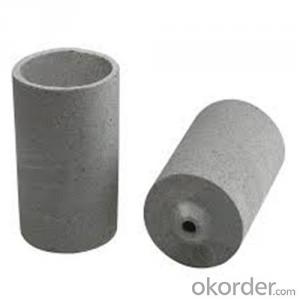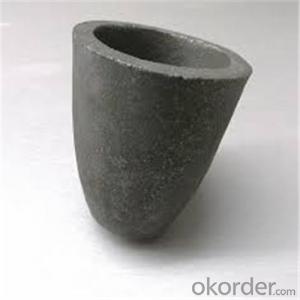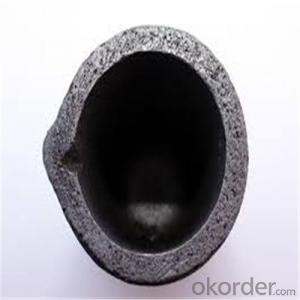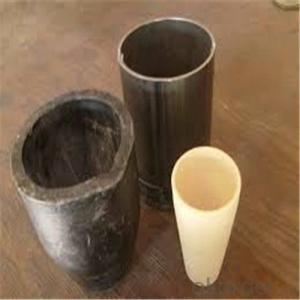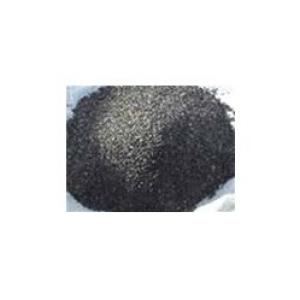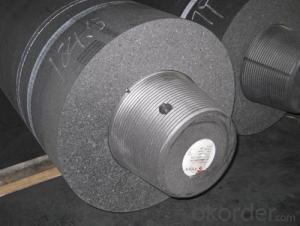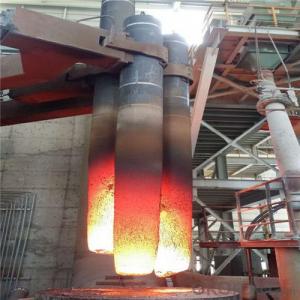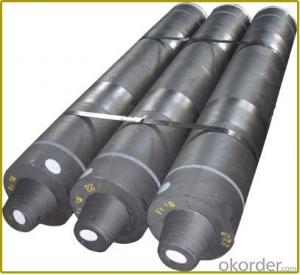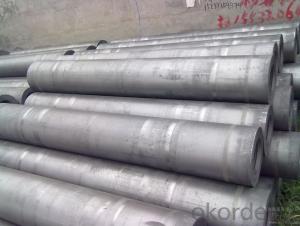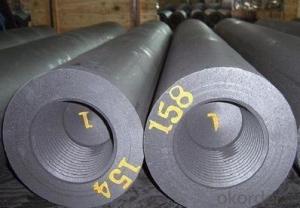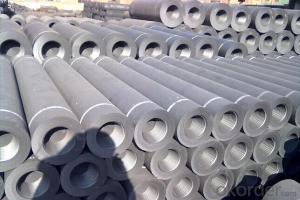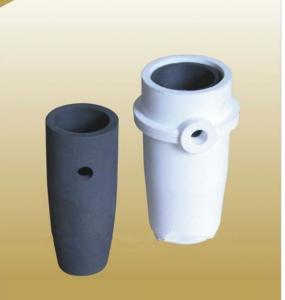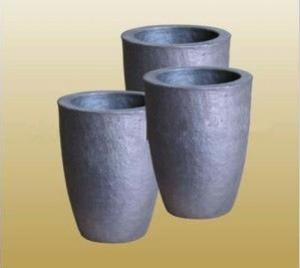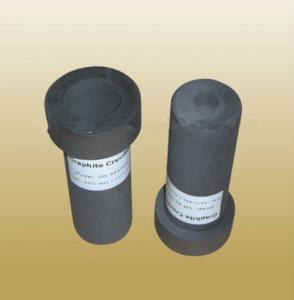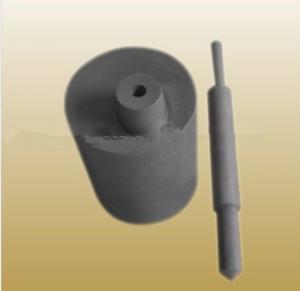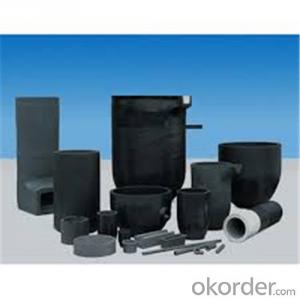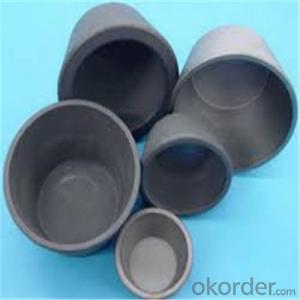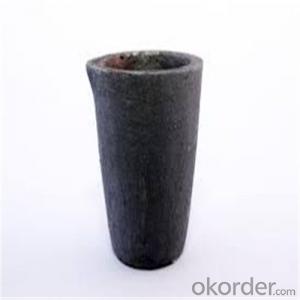Refractory Crucibles Sic Crucible For Melting Copper/Brass
- Loading Port:
- Shanghai
- Payment Terms:
- TT OR LC
- Min Order Qty:
- 1 pc
- Supply Capability:
- 1000 pc/month
OKorder Service Pledge
OKorder Financial Service
You Might Also Like
Quick Details for Refractory Crucibles Sic Crucible For Melting Copper/Brass/Aluminum
| Type: | High Strength, graphite crucible crucible | Application: | melting metal | Height: | as your requirements |
| Composition: | High Pure | Top Diameter: | 10-600mm | Bottom Diameter: | 10-1000mm |
| Place of Origin: | China (Mainland) | Brand Name: | Model Number: | ||
| Color: | Black grey | Si3N4%: | 5min | Fe2O3%: | 0.7max |
| C%: | 30-45 | Apparent porosity: | 30max | Refractoriness: | 1680 |
| Bulk Density: | 1.71min | Using life: | >5000 hours | MAX temperature: | 1600c |
Packaging & Delivery
| Packaging Details: | Seaworty packing or as per customer's detail requirement of graphite crucible. |
| Delivery Detail: | within 20-30 days after confirm order of graphite cru |
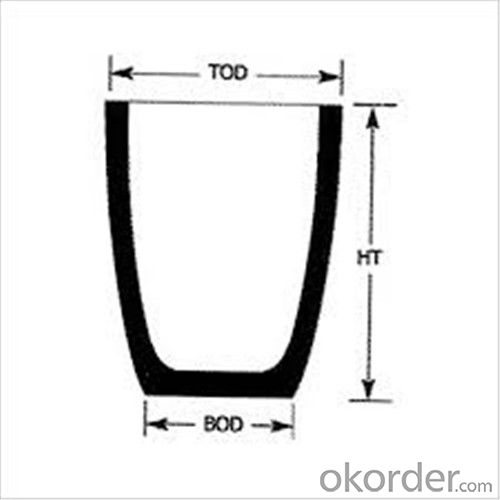

Refractory Crucibles Sic Crucible For Melting Copper/Brass/Aluminum
Physicochemical Properties
Type of Crucible | Type S | Type D |
Carbon Content/% | ≥38 | ≥45 |
Bulk Density/(g/cm3) | ≥1.70 | ≥1.85 |
Apparent Porosity/% | ≤29 | ≤21 |
Compression Strength/MPa | ≥20 | ≥25 |
Refractoriness/°C | ≥1400 | ≥1400 |
Type S: Clay graphite crucible
Type D: Isostatic pressing graphite crucible
Cited from CNS China National Standard of Graphite Crucible, which is solely drifted by TIANFU company.
Content Composition
C% | Sic% | AL2O3% | SIO2% |
45%-50% | 20%-30% | 10%-12% | 15-25% |
FAQ
1.What's your MOQ?
We will indicate the MOQ for each item in the quotation list. We accept the sample and trail order.
2.Can I negotiate the Prices?
Sure, we may consider discounts for bulk order of products.
3.How long will it take to complete my order?
For the stock items, we can arrange the shippment within 2~3days after received your payment. For the customized items, we will indicate the delivery time in the quotation list.
4.Can you give warranty of your products?
Yes, we extend a 100% satifisfaction guarantee on all items. Please feel free to provide timely feedback if you're not satisfied with N&D's Quality and Service. For the overseas orders, if there is a quality problem, please kindly to provide the picturers to show the problem by e-mail. We will provide the replacements to you at our cost according to actual conditions.
5.Can I visit you?
Sure. If you're a volume buyer and would like to visit our in-house products and production line, please contact us to make an appointment.
- Q:Can graphite crucibles be used for carbon nanotube synthesis?
- Yes, graphite crucibles can be used for carbon nanotube synthesis. Graphite has high thermal conductivity and can withstand high temperatures, making it suitable for growing carbon nanotubes through chemical vapor deposition methods.
- Q:Graphite and diamond are elemental elements made of carbon. Why are physical properties so different?
- Purpose: GraphiteIn the metallurgical industry, used in the manufacture of graphite crucible and foundry mold surface coating and furnace lining and protective slag;Electrical industry, do electrodes, brushes, batteries, positive conductive materials, carbon tubes and so on;In the chemical industry, it is used as catalyst material for acid and alkali products and chemical fertilizer industry, as well as high temperature resistant and high pressure seals;In addition, it can also be used as lubricant, anticorrosive paint, pigment, pencil core, gunpowder, neutron reduction agent in atomic reactor and anti corrosion agent in aerospace industry
- Q:How does the gas permeability of graphite affect crucible performance?
- The gas permeability of graphite plays a crucial role in crucible performance. Graphite's high gas permeability allows for the escape of gases and volatile compounds during high-temperature processes. This helps prevent pressure build-up, potential explosions, and contamination of the material being processed. Additionally, the permeability of graphite assists in maintaining a stable temperature within the crucible, enhancing the efficiency and effectiveness of the overall process.
- Q:What are the carbon elements? What are their structures? What are their properties and uses?
- Graphite, diamond, fullerene (C60) in recent years, scientists have found that in addition to diamond, graphite, and some new existence in the form of element carbon. The earlier found and has made important progress in the study of the C60 molecule.
- Q:Can a graphite crucible be used for silicon melting?
- No, a graphite crucible cannot be used for silicon melting because silicon has a high affinity for carbon and would react with the graphite crucible, leading to contamination of the silicon melt.
- Q:How do you determine the appropriate crucible tongs for a specific application?
- To determine the appropriate crucible tongs for a specific application, you need to consider several factors. First, assess the size and shape of the crucible you will be using. Ensure that the tongs can securely grip and handle the crucible without any risk of slippage or damage. Additionally, consider the material being used in the crucible and the temperature it will be subjected to. Select tongs made from a material that can withstand the heat and chemical reactivity of the application. Finally, consider the weight of the crucible and the amount of control you require during handling. Choose tongs that are comfortable to hold and provide the necessary grip and control for safe and efficient handling.
- Q:How does the wall thickness of a graphite crucible affect the melting process?
- The melting process is significantly influenced by the thickness of the graphite crucible walls. The walls' thickness determines both the crucible's heat transfer rate and overall efficiency. If the wall is thicker, it possesses greater thermal mass, enabling it to absorb and retain more heat. This proves advantageous in applications where a gradual and controlled heating or cooling process is desired. The increased thermal mass aids in stabilizing the temperature, preventing rapid fluctuations that can negatively impact the melting process. Alternatively, a thinner wall possesses less thermal mass and facilitates faster heat transfer. This proves beneficial when quick and efficient melting is required. The thinner walls allow for swifter heat transfer to the material being melted, resulting in shorter melting times and increased productivity. However, it is crucial to note that a thinner wall may be more susceptible to thermal stress and cracking due to the greater temperature differentials between the inner and outer parts of the crucible. This can potentially contaminate the melted material or even cause the crucible to fail. Moreover, the wall thickness affects the crucible's overall durability and lifespan. Thicker walls generally exhibit greater resistance to wear and tear, providing a longer operational life. This becomes particularly important in high-temperature applications where the crucible is exposed to extreme conditions. To summarize, the wall thickness of a graphite crucible directly impacts the melting process. Thicker walls provide improved temperature stability but may result in longer melting times, while thinner walls allow for faster heat transfer but may be more susceptible to thermal stress. Selecting the appropriate wall thickness depends on the specific requirements of the melting process and should be carefully considered to achieve optimal results.
- Q:Can graphite crucibles be used for carbon nanotube synthesis?
- Graphite crucibles are capable of being utilized in the synthesis of carbon nanotubes. Due to its high melting point and chemical stability at elevated temperatures, graphite serves as a suitable material for this purpose. In the process of synthesizing carbon nanotubes, a carbon source is commonly subjected to intense heat, and graphite crucibles have the ability to endure such extreme conditions without undergoing reactions or contaminating the nanotubes. Moreover, graphite crucibles possess efficient thermal conductivity, which aids in maintaining a consistent temperature throughout the synthesis procedure. Consequently, graphite crucibles are extensively employed in laboratories and industries for the fabrication of carbon nanotubes.
- Q:Does the graphite metal pad have any requirements on the sealing surface?
- The graphite composite gasket can be processed into the following forms according to the needs of use: 1. basic graphite composite gasket, 2. package inner graphite composite gasket, 3. outer graphite composite gasket 4., inner and outer edge graphite composite gasket. The graphite composite gasket has the advantages of keeping the excellent performance of the original gasket, easy installation and disassembly, uneasy damage, and preventing the medium from eroding the gasket and improving the pressure resistance. Commonly used wrapping material is 304 or 316 stainless steel.
- Q:What are the different methods of measuring the temperature inside a graphite crucible?
- There exist several approaches for gauging the temperature inside a graphite crucible. 1. Thermocouples, extensively employed in various industrial settings, including within graphite crucibles, are composed of two distinct metal wires fused to form a junction. When a temperature discrepancy arises between the junction and the other end of the wires, a voltage is produced, which can be quantified to ascertain the temperature. Thermocouples are fairly uncomplicated, cost-effective, and deliver precise temperature readings. 2. Infrared (IR) Pyrometers rely on the concept of thermal radiation to gauge the temperature of an object without establishing direct contact. These devices detect the infrared radiation emitted by the graphite crucible, which is directly proportional to its temperature. IR pyrometers are non-contact and offer rapid temperature readings, making them suitable for instances where direct contact is unfeasible or undesirable. 3. Optical Pyrometers employ the principle of color temperature to determine the temperature of an object. These devices operate by comparing the color of the object being measured to a calibrated scale. By adjusting the scale until the colors correspond, the temperature can be deduced. Optical pyrometers are commonly used in high-temperature scenarios and yield precise temperature readings. 4. Radiation Thermometers, also referred to as non-contact infrared thermometers or infrared thermometers, ascertain the temperature by sensing the thermal radiation emitted by the graphite crucible. Typically, these devices employ a detector to transform the thermal radiation into an electrical signal, which is then processed to ascertain the temperature. Radiation thermometers are non-contact, swift, and provide accurate temperature measurements. 5. Contact Probes, such as thermocouple probes or resistance temperature detectors (RTDs), can be directly inserted into the graphite crucible to gauge its temperature. These probes are typically crafted from materials resistant to high temperatures and are connected to a temperature indicator or controller. Contact probes furnish direct temperature readings and are commonly utilized in situations necessitating continuous monitoring and control of temperature. Each of these methods possesses unique advantages and limitations. The choice of measurement technique hinges on factors such as temperature range, precision requirements, response time, and the specific attributes of the graphite crucible and its contents.
1. Manufacturer Overview |
|
|---|---|
| Location | |
| Year Established | |
| Annual Output Value | |
| Main Markets | |
| Company Certifications | |
2. Manufacturer Certificates |
|
|---|---|
| a) Certification Name | |
| Range | |
| Reference | |
| Validity Period | |
3. Manufacturer Capability |
|
|---|---|
| a)Trade Capacity | |
| Nearest Port | |
| Export Percentage | |
| No.of Employees in Trade Department | |
| Language Spoken: | |
| b)Factory Information | |
| Factory Size: | |
| No. of Production Lines | |
| Contract Manufacturing | |
| Product Price Range | |
Send your message to us
Refractory Crucibles Sic Crucible For Melting Copper/Brass
- Loading Port:
- Shanghai
- Payment Terms:
- TT OR LC
- Min Order Qty:
- 1 pc
- Supply Capability:
- 1000 pc/month
OKorder Service Pledge
OKorder Financial Service
Similar products
New products
Hot products
Hot Searches
Related keywords
